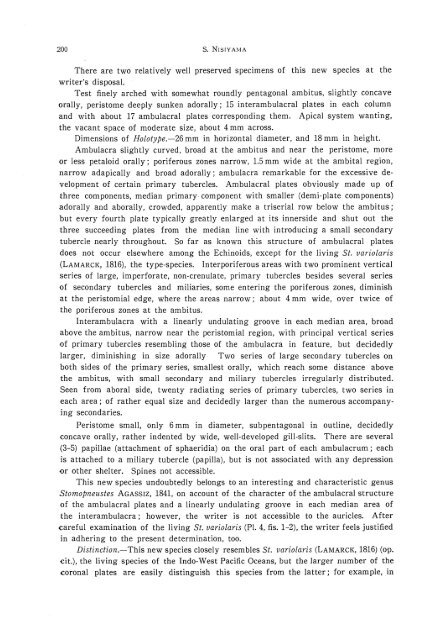the echinoid fauna from japan and adjacent regions part i
the echinoid fauna from japan and adjacent regions part i
the echinoid fauna from japan and adjacent regions part i
You also want an ePaper? Increase the reach of your titles
YUMPU automatically turns print PDFs into web optimized ePapers that Google loves.
200 S. NISIYAMA<br />
There are two relatively well preserved specimens of this new species at <strong>the</strong><br />
writer's disposal.<br />
Test finely arched with somewhat roundly pentagonal ambitus, slightly concave<br />
orally, peristome deeply sunken adorally; 15 interambulacral plates in each column<br />
<strong>and</strong> with about 17 ambulacral plates corresponding <strong>the</strong>m. Apical system wanting,<br />
<strong>the</strong> vacant space of moderate size, about 4 mm across.<br />
Dimensions of Halatype.-26 mm in horizontal diameter, <strong>and</strong> 18 mm in height.<br />
Ambulacra slightly curved, broad at <strong>the</strong> ambitus <strong>and</strong> near <strong>the</strong> peristome, more<br />
or less petaloid orally; poriferous zones narrow, 1.5 mm wide at <strong>the</strong> ambital region,<br />
narrow adapically <strong>and</strong> broad adorally; ambulacra remarkable for <strong>the</strong> excessive development<br />
of certain primary tubercles. Ambulacral plates obviously made up of<br />
three components, median primary component with smaller (demi-plate components)<br />
adorally <strong>and</strong> aborally, crowded, apparently make a triserial row below <strong>the</strong> ambitus;<br />
but every fourth plate typically greatly enlarged at its innerside <strong>and</strong> shut out <strong>the</strong><br />
three succeeding plates <strong>from</strong> <strong>the</strong> median line with introducing a small secondary<br />
tubercle nearly throughout. So far as known this structure of ambulacral plates<br />
does not occur elsewhere among <strong>the</strong> Echinoids, except for <strong>the</strong> living St. varialaris<br />
(LAMARCK, 1816), <strong>the</strong> type-species. Interporiferous areas with two prominent vertical<br />
series of large, imperforate, non-crenulate, primary tubercles besides several series<br />
of secondary tubercles <strong>and</strong> miliaries, some entering <strong>the</strong> poriferous zones, diminish<br />
at <strong>the</strong> peristomial edge, where <strong>the</strong> areas narrow; about 4 mm wide, over twice of<br />
<strong>the</strong> poriferous zones at <strong>the</strong> ambitus.<br />
Interambulacra with a linearly undulating groove in each median area, broad<br />
above <strong>the</strong> ambitus, narrow near <strong>the</strong> peristomial region, with principal vertical series<br />
of primary tubercles resembling those of <strong>the</strong> ambulacra in feature, but decidedly<br />
larger, diminishing in size adorally Two series of large secondary tubercles on<br />
both sides of <strong>the</strong> primary series, smallest orally, which reach some distance above<br />
<strong>the</strong> ambitus, with small secondary <strong>and</strong> miliary tubercles irregularly distributed.<br />
Seen <strong>from</strong> aboral side, twenty radiating series of primary tubercles, two series in<br />
each area; of ra<strong>the</strong>r equal size <strong>and</strong> decidedly larger than <strong>the</strong> numerous accompanying<br />
secondaries.<br />
Peristome small, only 6 mm in diameter, subpentagonal in outline, decidedly<br />
concave orally, ra<strong>the</strong>r indented by wide, well-developed gill-slits. There are several<br />
(3-5) papillae (attachment of sphaeridia) on <strong>the</strong> oral <strong>part</strong> of each ambulacrum; each<br />
is attached to a miliary tubercle (papilla), but is not associated with any depression<br />
Qr o<strong>the</strong>r shelter. Spines not accessible.<br />
This new species undoubtedly belongs to an interesting <strong>and</strong> characteristic genus<br />
Stamapneustes AGASSIZ, 1841, on account of <strong>the</strong> character of <strong>the</strong> ambulacral structure<br />
of <strong>the</strong> ambulacral plates <strong>and</strong> a linearly undulating groove in each median area of<br />
<strong>the</strong> interambulacra; however, <strong>the</strong> writer is not accessible to <strong>the</strong> auricles. After<br />
careful examination of <strong>the</strong> living St. varialaris (PI. 4, fis. 1-2), <strong>the</strong> writer feels justified<br />
in adhering to <strong>the</strong> present determination, too.<br />
Distinctian.-This new species closely resembles St. varialaris (LAMARCK, 1816) (o-p.<br />
cit.), <strong>the</strong> living species of <strong>the</strong> Indo-West Pacific Oceans, but <strong>the</strong> larger number of <strong>the</strong><br />
coronal plates are easily distinguish this species <strong>from</strong> <strong>the</strong> latter; for example, in












